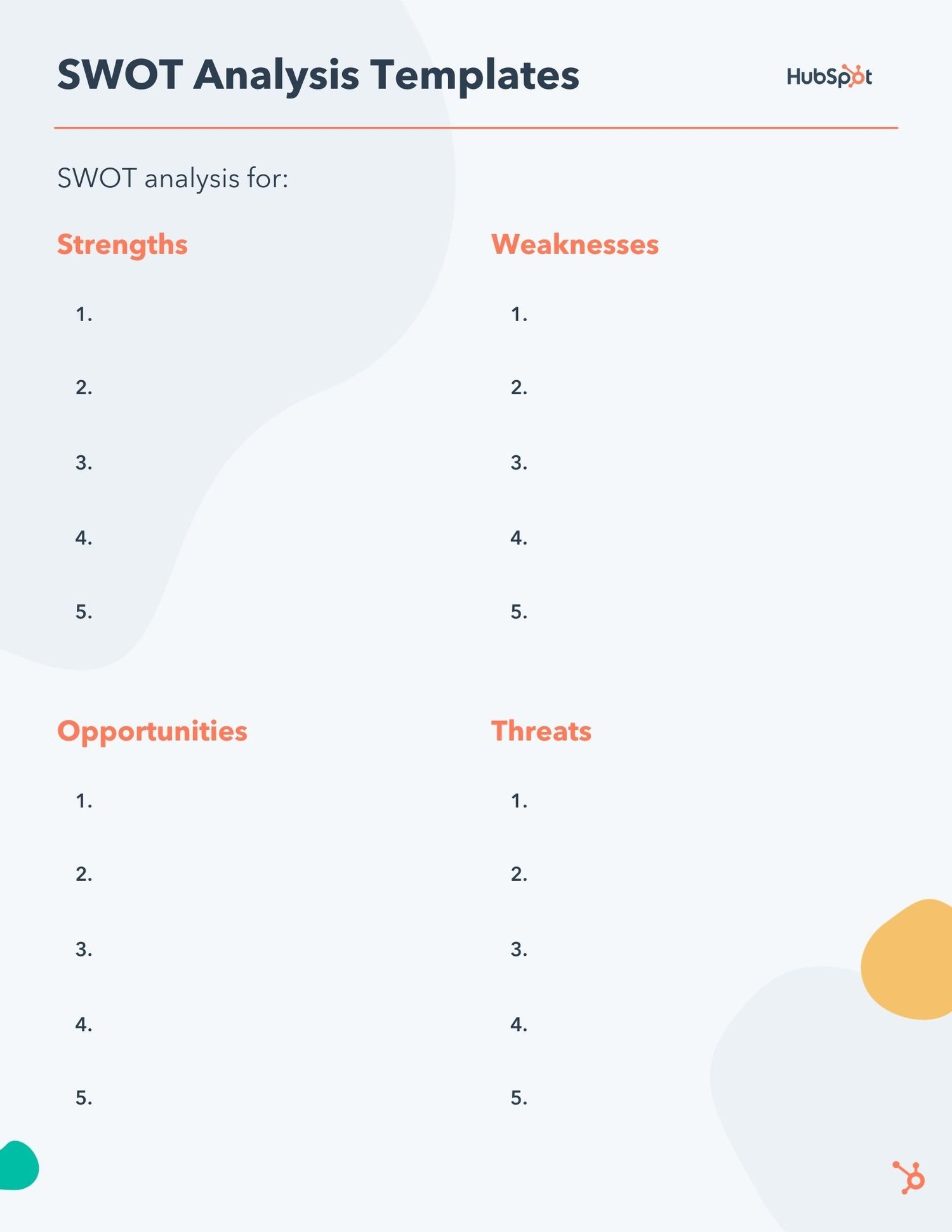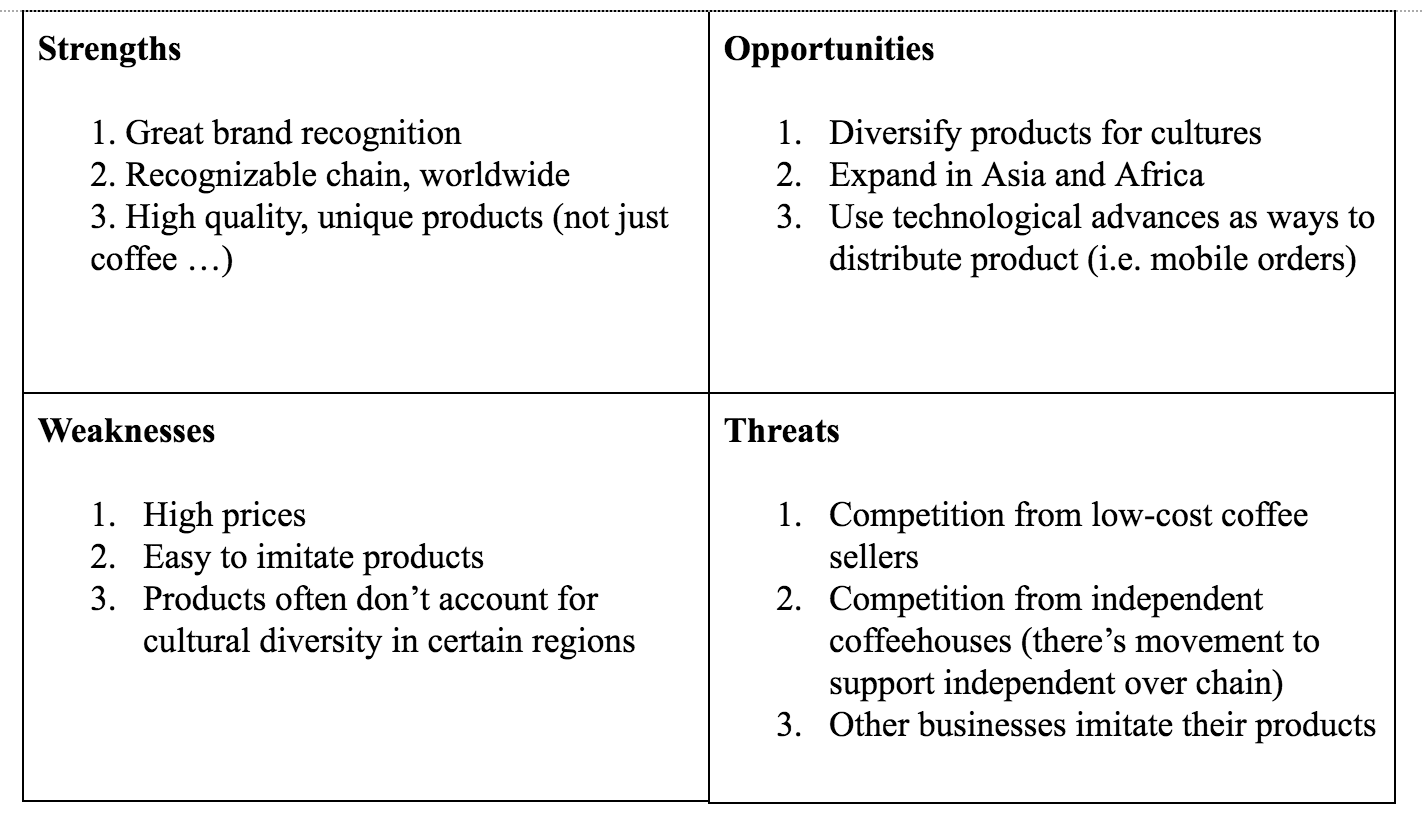A SWOT analysis is a useful technique to evaluate a new project or objective your business faces, or your business as a whole.
Essentially, a SWOT analysis is a roadmap for how you should move forward with your business, which opportunities you’re missing out on, and which challenges you should tackle.
It’s an effective method to maximize opportunities while minimizing negative factors associated with a given project or objective. Plus, it lets you unbiasedly evaluate your business’s strengths and weaknesses, which is key to avoiding unnecessary errors down the road from lack of insight.
Here, we’ll provide a SWOT analysis template, and conduct SWOT analyses on major brands Apple and Starbucks. When you’re done reading, you’ll have all the inspiration and tactical advice you need to tackle a SWOT analysis for yourself.
You know a SWOT analysis is important, but, how do you conduct one?
There are four steps you’ll want to take when evaluating your business as a whole, or your product in particular. Before you start, you’ll need to figure out what you’re evaluating with your SWOT analysis. Creating a social media program, launching a new product, or considering a brand re-design are all good reasons to conduct a SWOT analysis.
Use this SWOT Analysis Template.
To visualize your SWOT analysis, it's helpful to make a table. Here, I’ve created a sample using a simple Google Doc table -- feel free to use the model yourself, or create your own as it suits your needs.
Make a SWOT Analysis Table

Use the four steps below as a references when filling in your table.
1. Identify your strengths.
Let’s say you want to use a SWOT analysis to evaluate your new social media strategy.
If you’re looking at a new social media program, perhaps you want to evaluate how your brand is perceived by the public -- is it easily recognizable and well-known? Even if it’s not popular with a widespread group, is it well-received by a specific audience in particular?
Next, think about your process: is it effective, or innovative? Is there good communication between your marketing and sales to ensure both departments use similar vocabulary when discussing your product?
Finally, evaluate your social media message, and in particular, how it differs from the rest of the industry. I’m willing to bet you can make a lengthy list of some major strengths of your social media strategy over your competitors, so try to dive into your strengths from there.
2. Identify your weaknesses.
If you’re examining a new social media strategy, it’s critical to foresee any potential negative factors that could mitigate your success.
Start by asking yourself these questions: First, if I were a consumer, what would prevent me from buying this product, or engaging with this business? What would make me click away from the screen?
Second, what do I foresee as the biggest hinderance to my employees’ productivity, or their ability to get the job done efficiently? What derails their social media efforts?
When identifying weaknesses, consider what areas of your business are the least profitable, where you lack certain resources, or what costs you the most time and money. Take input from employees in different departments, as they’ll likely see weaknesses you hadn’t considered.
3. Consider your opportunities.
This is your chance to dream big. What are some opportunities for your social media strategy you hope, but don’t necessarily expect, to reach?
For instance, maybe you’re hoping your Facebook ads will attract a new, larger demographic. Maybe you’re hoping your YouTube video gets 10,000 views, and increases sales by 10%.
Whatever the case, it’s important to include potential opportunities in your SWOT analysis. Ask yourself these questions: What technologies do I want my business to use to make it more effective? What new target audience do I want to reach? How can the business stand out more in the current industry? Is there something our customers complain about that we could fix with our social media strategy?
The opportunities category goes hand-in-hand with the weaknesses category. Once you’ve made a list of weaknesses, it should be easy to create a list of potential opportunities that could arise if you eliminate your weaknesses.
4. Contemplate your threats.
It’s likely, especially if you’re prone to worrying, you already have a good list of threats in your head.
If not, gather your employees and brainstorm: what obstacles might prevent us from reaching our social media goals? What’s going on in the industry, or with our competitors, that might mitigate our success? Is there new technology out there that could conflict with our product?
Writing down your threats helps you evaluate them objectively. For instance, maybe you list your threats in terms of least and most likely to occur, and divide and conquer each. If one of your biggest threats is your competitor’s popular Instagram account, you could work with your marketing department to create content that showcases your product’s unique features.
SWOT Analysis Examples
The template above helps get you started on your own SWOT analysis.
But, if you’re anything like me, it’s not enough to see a template. To fully understand a concept, you need to see how it plays out in the real world.
Here are two examples of SWOT analyses on major corporations, Apple and Starbucks. The list of strengths and weaknesses is not exhaustive, and I’m sure you could add some yourself, but hopefully, it’s enough to inspire your own SWOT analysis.
Apple’s SWOT analysis
Here’s how we’d conduct a SWOT analysis on Apple.
 First off, strengths. While Apple has many strengths, let’s identify the top three:
First off, strengths. While Apple has many strengths, let’s identify the top three:
- Brand recognition
- High prices
- Innovative products
Apple’s brand is undeniably valuable, and was named the world’s most valuable brand by Forbes. Since it’s easily recognized, Apple can produce new products and almost ensure a certain degree of success by virtue of the brand name itself.
This degree of recognition lends itself to Apple’s ability to sell products at extremely high prices. For instance, in 2016, Apple sold 78 million iPhones, the average cost of which was $695. In comparison, Samsung sold their smartphones for $500 less. And yet, 92% of the profits in the smartphone category for 2016 went to Apple. Often, people don’t care about price as much as they care about brand recognition.
Lastly, their innovative products: Apple didn’t earn its reputation for nothing. They create highly innovative products, which are often at the forefront of the industry.
Next, let’s look at three of Apple’s weaknesses.
- High prices
- Closed ecosystem
- Lack of experimentation
While the high prices don’t deter Apple’s middle and high class customer-base, they do hinder Apple’s ability to reach a lower-class demographic.
Apple also suffers from its own exclusivity. Apple controls all its services and products in-house, and while many customers become loyal brand advocates for this reason, it means all burdens fall on Apple employees.
Ultimately, Apple’s tight control over who distributes their products limit their market reach.
Lastly, Apple is held to a high standard when it comes to creating and distributing products. Apple’s brand carries a high level of prestige, but that level of recognition inhibits Apple from taking risks and experimenting freely with new products that could fail.
Now, let’s take a look at opportunities for Apple.
It’s easy to recognize opportunities for improvement, once you consider Apple’s weaknesses. Here’s a list of three we came up with:
- Expand distribution options
- Create new product lines
- Technological advancement
One of Apple’s biggest weaknesses is its distribution network, which, in the name of exclusivity, remains relatively small. If Apple expanded its network and enabled third-party businesses to sell its products, it could reach more people globally, while alleviating some of the stress currently put on in-house employees.
There are also plenty of opportunities for Apple to create new products. Apple could consider creating more affordable products to reach a larger demographic, or spreading out into new industries -- Apple self-driving cars, perhaps?
Finally, Apple could continue advancing its products’ technology. Apple can take existing products and refine them, ensuring each product offers as many unique features as possible.
Finally, let’s look at threats to Apple.
Believe it or not, they do exist.
Here are three of Apple’s biggest threats:
- Tough competition
- Lawsuits
- International issues
Apple isn’t the only innovative tech company out there, and it continues to face tough competition from Samsung, Google, and other major forces. Many of Apple’s weaknesses hinder Apple’s ability to compete with the tech corporations that have more freedom to experiment, or that don’t operate in a closed ecosystem.
A second threat to Apple is lawsuits. Over the last few years, Apple has faced a bunch of lawsuits, particularly between Apple and Samsung, and so far it has only won one case. These lawsuits interfere with Apple’s reputable image, and could steer some customers to purchasing elsewhere.
Finally, Apple needs to improve its reach internationally. It isn’t number one in China, and doesn’t have a very positive relationship with the Chinese government. Then, in India, which has one of the largest consumer markets in the world, Apple’s market share is low, and the company has trouble bringing stores to India’s market.
If Apple can’t compete globally the way Samsung or Google can, it risks falling behind in the industry.
Starbucks SWOT Analysis
Now that we’ve explored the nuances involved with a SWOT analysis, let’s fill out a SWOT template using Starbucks as an example.
Here’s how we’d fill out a SWOT template, if we were Starbucks:
Dine-In Thai Restaurant SWOT Analysis
Some small-business marketers may have difficulty relating to the SWOT's of big brands like Apple and Starbucks, so here's an example of how a restaurant might visualize each element:
 While a Thai or any other restaurant might not be as worried about high-level lawsuits like Apple, the small business might be more worried about competitors or disruptors that might enter the playing field.
While a Thai or any other restaurant might not be as worried about high-level lawsuits like Apple, the small business might be more worried about competitors or disruptors that might enter the playing field.
Local Boutique SWOT Analysis
In another small-business example, a local boutique might be well known in its neighborhood, but it also might take time to build an online presence or get its products in an online store. Because of this, some of its strengths and opportunities might relate to physical factors while weaknesses and threats might relate to online situations.

When to Use a SWOT Analysis
Ultimately, a SWOT analysis can measure and tackle both big and small challenges, and opportunities, and both big and little strengths and weaknesses.
While the examples above focus on businesses in general, you can also use a SWOT analysis to evaluate and predict how a singular product will play out in the market.
Hopefully, our SWOT template will supplement your market research and business analysis, and provide fair insights into how to optimize your products for bigger payoffs, and less hurdles.
from Marketing https://ift.tt/2rJH0Kc


No comments:
Post a Comment